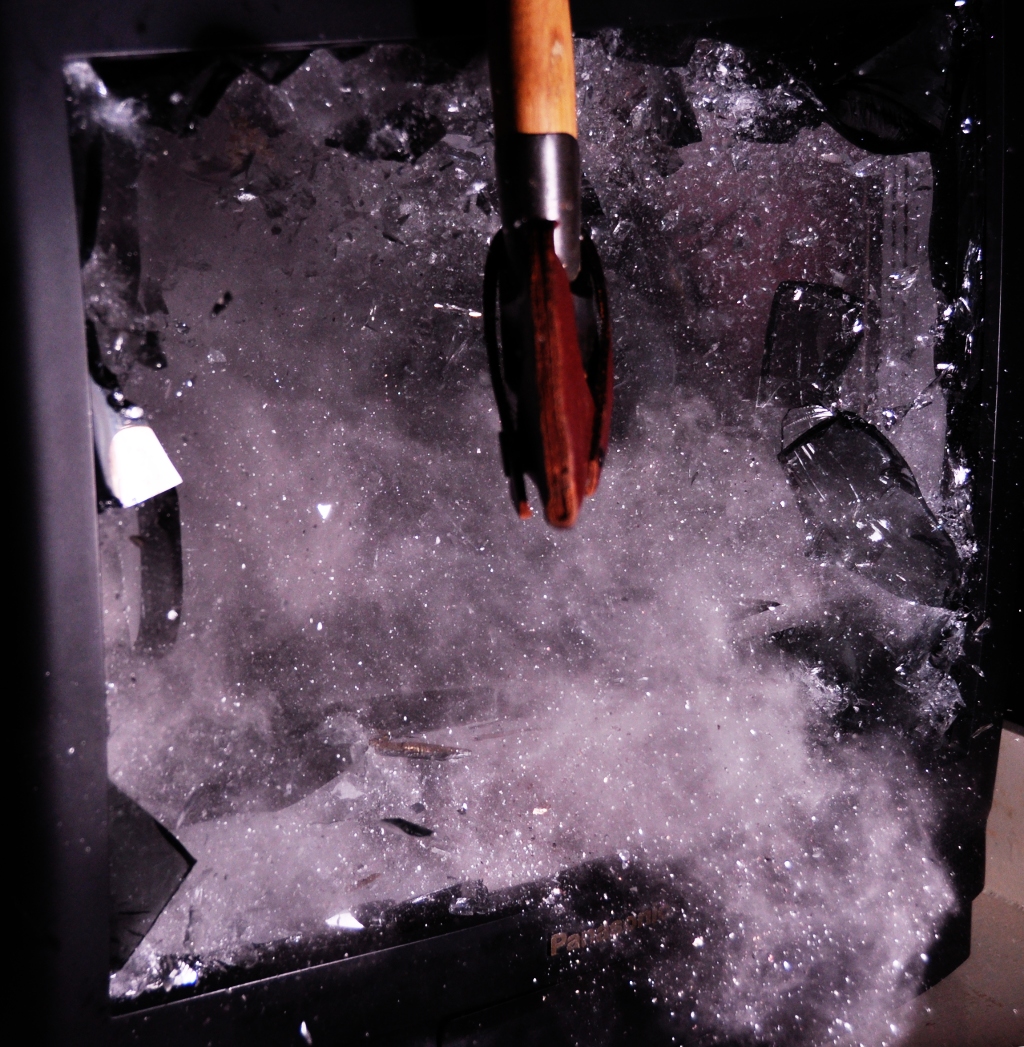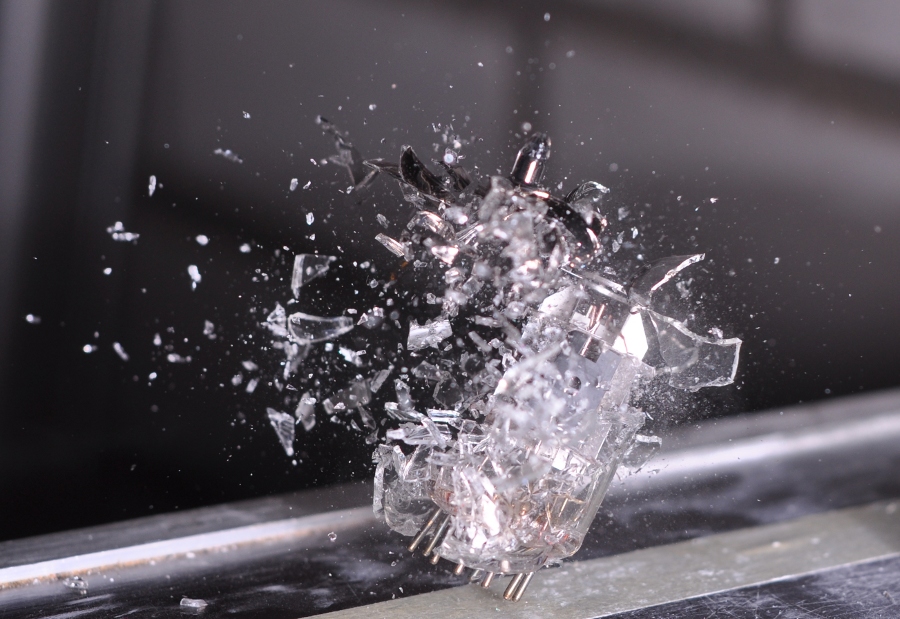Implosion (mechanical Process) on:
[Wikipedia]
[Google]
[Amazon]
Implosion is the collapse of an object into itself from a pressure differential or gravitational force. The opposite of


Converging Shock Waves
Mechanics Implosion
explosion
An explosion is a rapid expansion in volume of a given amount of matter associated with an extreme outward release of energy, usually with the generation of high temperatures and release of high-pressure gases. Explosions may also be generated ...
(which expands the volume
Volume is a measure of regions in three-dimensional space. It is often quantified numerically using SI derived units (such as the cubic metre and litre) or by various imperial or US customary units (such as the gallon, quart, cubic inch) ...
), implosion reduces the volume occupied and concentrates matter
In classical physics and general chemistry, matter is any substance that has mass and takes up space by having volume. All everyday objects that can be touched are ultimately composed of atoms, which are made up of interacting subatomic pa ...
and energy
Energy () is the physical quantity, quantitative physical property, property that is transferred to a physical body, body or to a physical system, recognizable in the performance of Work (thermodynamics), work and in the form of heat and l ...
. Implosion involves a difference between internal (lower) and external (higher) pressure, or inward and outward forces, that is so large that the structure collapses inward into itself, or into the space it occupied if it is not a completely solid object. Examples of implosion include a submarine being crushed by hydrostatic pressure
Hydrostatics is the branch of fluid mechanics that studies fluids at hydrostatic equilibrium and "the pressure in a fluid or exerted by a fluid on an immersed body". The word "hydrostatics" is sometimes used to refer specifically to water and o ...
and the collapse of a star
A star is a luminous spheroid of plasma (physics), plasma held together by Self-gravitation, self-gravity. The List of nearest stars and brown dwarfs, nearest star to Earth is the Sun. Many other stars are visible to the naked eye at night sk ...
under its own gravitational pressure.
In some but not all cases, an implosion propels material outward, for example due to the force of inward falling material rebounding, or peripheral material being ejected as the inner parts collapse. If the object was previously solid, then implosion usually requires it to take on a more dense
Density (volumetric mass density or specific mass) is the ratio of a substance's mass to its volume. The symbol most often used for density is ''ρ'' (the lower case Greek letter rho), although the Latin letter ''D'' (or ''d'') can also be use ...
form—in effect to be more concentrated, compressed, or converted into a denser material.
Examples
Nuclear weapons
In an implosion-typenuclear weapon design
Nuclear weapons design are physical, chemical, and engineering arrangements that cause the physics package of a nuclear weapon to detonate. There are three existing basic design types:
# Pure fission weapons are the simplest, least technically de ...
, a sphere of plutonium
Plutonium is a chemical element; it has symbol Pu and atomic number 94. It is a silvery-gray actinide metal that tarnishes when exposed to air, and forms a dull coating when oxidized. The element normally exhibits six allotropes and four ...
, uranium
Uranium is a chemical element; it has chemical symbol, symbol U and atomic number 92. It is a silvery-grey metal in the actinide series of the periodic table. A uranium atom has 92 protons and 92 electrons, of which 6 are valence electrons. Ura ...
, or other fissile
In nuclear engineering, fissile material is material that can undergo nuclear fission when struck by a neutron of low energy. A self-sustaining thermal Nuclear chain reaction#Fission chain reaction, chain reaction can only be achieved with fissil ...
material is imploded by a spherical arrangement of explosive charges. This decreases the material's volume and thus increases its density by a factor of two to three, causing it to reach critical mass
In nuclear engineering, critical mass is the minimum mass of the fissile material needed for a sustained nuclear chain reaction in a particular setup. The critical mass of a fissionable material depends upon its nuclear properties (specific ...
and create a nuclear explosion
A nuclear explosion is an explosion that occurs as a result of the rapid release of energy from a high-speed nuclear reaction. The driving reaction may be nuclear fission or nuclear fusion or a multi-stage cascading combination of the two, th ...
.
In some forms of thermonuclear weapons
A thermonuclear weapon, fusion weapon or hydrogen bomb (H-bomb) is a second-generation nuclear weapon design. Its greater sophistication affords it vastly greater destructive power than first-generation nuclear bombs, a more compact size, a lowe ...
, the energy from this explosion is then used to implode a capsule of fusion fuel before igniting it, causing a fusion reaction
Nuclear fusion is a reaction in which two or more atomic nuclei combine to form a larger nuclei, nuclei/neutron by-products. The difference in mass between the reactants and products is manifested as either the release or absorption of energy ...
(see Teller–Ulam design
A thermonuclear weapon, fusion weapon or hydrogen bomb (H-bomb) is a second-generation nuclear weapon design. Its greater sophistication affords it vastly greater destructive power than first-generation nuclear bombs, a more compact size, a lowe ...
). In general, the use of radiation to implode something, as in a hydrogen bomb or in laser driven inertial confinement fusion
Inertial confinement fusion (ICF) is a fusion energy process that initiates nuclear fusion reactions by compressing and heating targets filled with fuel. The targets are small pellets, typically containing deuterium (2H) and tritium (3H).
Typical ...
, is known as radiation implosion.
Fluid dynamics
Cavitation
Cavitation in fluid mechanics and engineering normally is the phenomenon in which the static pressure of a liquid reduces to below the liquid's vapor pressure, leading to the formation of small vapor-filled cavities in the liquid. When sub ...
(bubble formation/collapse in a fluid) involves an implosion process. When a cavitation bubble forms in a liquid (for example, by a high-speed water propeller
A propeller (often called a screw if on a ship or an airscrew if on an aircraft) is a device with a rotating hub and radiating blades that are set at a pitch to form a helical spiral which, when rotated, exerts linear thrust upon a working flu ...
), this bubble is typically rapidly collapsed—imploded—by the surrounding liquid.
Astrophysics
Implosion is a key part of thegravitational collapse
Gravitational collapse is the contraction of an astronomical object due to the influence of its own gravity, which tends to draw matter inward toward the center of gravity. Gravitational collapse is a fundamental mechanism for structure formati ...
of large star
A star is a luminous spheroid of plasma (physics), plasma held together by Self-gravitation, self-gravity. The List of nearest stars and brown dwarfs, nearest star to Earth is the Sun. Many other stars are visible to the naked eye at night sk ...
s, which can lead to the creation of supernova
A supernova (: supernovae or supernovas) is a powerful and luminous explosion of a star. A supernova occurs during the last stellar evolution, evolutionary stages of a massive star, or when a white dwarf is triggered into runaway nuclear fusion ...
s, neutron star
A neutron star is the gravitationally collapsed Stellar core, core of a massive supergiant star. It results from the supernova explosion of a stellar evolution#Massive star, massive star—combined with gravitational collapse—that compresses ...
s and black hole
A black hole is a massive, compact astronomical object so dense that its gravity prevents anything from escaping, even light. Albert Einstein's theory of general relativity predicts that a sufficiently compact mass will form a black hole. Th ...
s.
In the most common case, the innermost part of a large star (called the core
Core or cores may refer to:
Science and technology
* Core (anatomy), everything except the appendages
* Core (laboratory), a highly specialized shared research resource
* Core (manufacturing), used in casting and molding
* Core (optical fiber ...
) stops burning and without this source of heat
In thermodynamics, heat is energy in transfer between a thermodynamic system and its surroundings by such mechanisms as thermal conduction, electromagnetic radiation, and friction, which are microscopic in nature, involving sub-atomic, ato ...
, the forces holding electron
The electron (, or in nuclear reactions) is a subatomic particle with a negative one elementary charge, elementary electric charge. It is a fundamental particle that comprises the ordinary matter that makes up the universe, along with up qua ...
s and proton
A proton is a stable subatomic particle, symbol , Hydron (chemistry), H+, or 1H+ with a positive electric charge of +1 ''e'' (elementary charge). Its mass is slightly less than the mass of a neutron and approximately times the mass of an e ...
s apart are no longer strong enough to do so. The core collapses in on itself exceedingly quickly, and becomes a neutron star
A neutron star is the gravitationally collapsed Stellar core, core of a massive supergiant star. It results from the supernova explosion of a stellar evolution#Massive star, massive star—combined with gravitational collapse—that compresses ...
or black hole
A black hole is a massive, compact astronomical object so dense that its gravity prevents anything from escaping, even light. Albert Einstein's theory of general relativity predicts that a sufficiently compact mass will form a black hole. Th ...
; the outer layers of the original star fall inwards and may rebound off the newly created neutron star (if one was created), creating a supernova
A supernova (: supernovae or supernovas) is a powerful and luminous explosion of a star. A supernova occurs during the last stellar evolution, evolutionary stages of a massive star, or when a white dwarf is triggered into runaway nuclear fusion ...
.
Cathode-ray tube and fluorescent lighting implosion
A high vacuum exists within allcathode-ray tube
A cathode-ray tube (CRT) is a vacuum tube containing one or more electron guns, which emit electron beams that are manipulated to display images on a phosphorescent screen. The images may represent electrical waveforms on an oscilloscope, a ...
s. If the outer glass envelope is damaged, a dangerous implosion may occur. The implosion may scatter glass pieces at dangerous speeds. While modern CRTs used in televisions and computer displays have epoxy-bonded face-plates or other measures to prevent shattering of the envelope, CRTs removed from equipment must be handled carefully to avoid injury.
Controlled structure demolition
Thedemolition
Demolition (also known as razing and wrecking) is the science and engineering in safely and efficiently tearing down buildings and other artificial structures. Demolition contrasts with deconstruction (building), deconstruction, which inv ...
of large buildings using precisely placed and timed explosions so that the structure collapses on itself is often erroneously described as ''implosion''.
See also
* ''Titan'' submersible implosion *Type II supernova
A Type II supernova or SNII (plural: ''supernovae'') results from the rapid collapse and violent explosion of a massive star. A star must have at least eight times, but no more than 40 to 50 times, the mass of the Sun () to undergo this type ...
References
External links
*{{commons category-inlineConverging Shock Waves
Mechanics Implosion